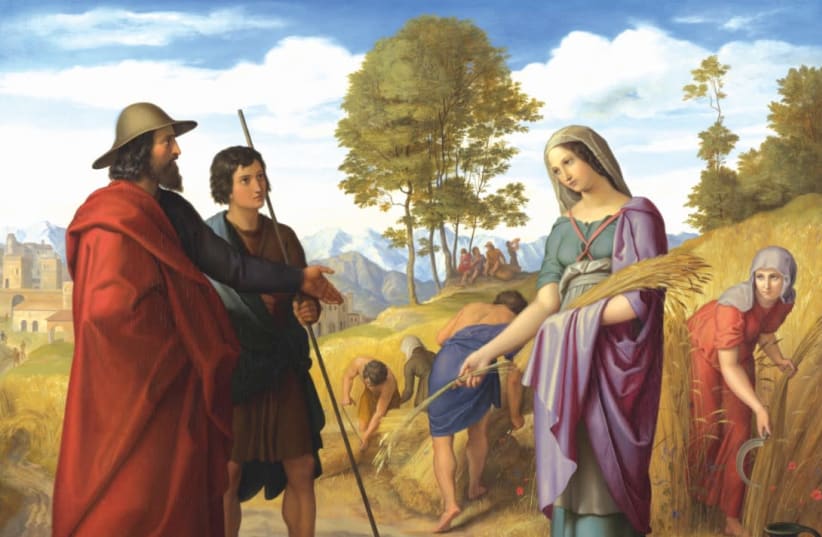No matter how familiar with these moving stories you think you might be, you will learn a great deal more by reading Rabbi Benjamin Segal’s extraordinary book about the Scroll of Ruth. He places it in context within Jewish history, provides a most refreshing and deep exploration of its content, unpacks its meaning and relevance for the contemporary reader, and raises a question as to whether it is a factual account or not.
Rabbi Segal is the former president of the Schechter Institute of Jewish Studies in Jerusalem, and this is his fourth book in a series on biblical texts, following his volumes on the Song of Songs, Psalms and Ecclesiastes. He has also written on Judaica, Zionism and education. In this book he clearly demonstrates his understanding of the time frame and context of the narrative.
Rabbi Segal has structured the text by having the same three elements within each of the chapters: a structural analysis, a translation, and finally a dual-level commentary. This commentary, in which he applies two levels of notation to the text, represents this book’s unique contribution. One level is represented by the footnotes at the bottom of the page that expand readers’ understanding of the text itself. The second level is represented by the endnotes in the back of the book for those who are interested in a more academic discussion. To enable us to understand and access the dual system, Rabbi Segal uses lowercase letters for the footnotes and numbers for the endnotes so readers can decide when they want to consult the more academic references.
In the introduction, he succinctly states the four main issues he will focus on throughout the text: 1) marriage and intermarriage, 2) references to King David, 3) references to biblical law, and 4) the chronology of the book in relation to the rest of the Bible.
Rabbi Segal then provides the societal context for the Book of Ruth by describing the daily life and culture at the time. He engages the reader in thinking more broadly about the story and what we can glean about the impact of Ruth’s Moabite background and her being both a descendant of Lot and a forebear of King David.
In addition, Rabbi Segal offers a refreshing discussion of the roles of women in the biblical story and how uncharacteristically both Naomi and Ruth seem to demonstrate a more modern conceptions of gender equality in the way Naomi decides to return to her homeland following the deaths of her husband and sons, how she takes control of her life, and how she directs Ruth to be active and somewhat assertive in finding a place for herself in what seems to be a foreign culture. It is only toward the end of the book that Ruth follows Naomi’s advice as she deepens her relationship with Boaz, which leads to marriage and children.
One of the more controversial scenes in the book is the “courting” and marriage of Boaz and Ruth, and Rabbi Segal speculates that Boaz and Naomi together might have worked out a courtship plan that was ready to implement when Ruth appeared at his side during the night. Rabbi Segal analyzes their relationship as being a variation of the “Levirate marriage extending the obligation beyond the brother to other relatives and making the levir identical to one who redeems land.” In his discussion he points out that although they are joined in family relations, the text itself separates land redemption and the Levirate marriage. Of course, at the same time the acceptance of Ruth as a convert by the people she meets and others who understand the depth of her expression of loyalty and devotion to Naomi as she proclaims, “Your people are my people, and your God, my God.”
Of course, as Rabbi Segal points out, Ruth herself is a fascinating personality, yet so little is known about her. In some ways she is a real mystery. Ultimately, she is a vehicle for conveying this story of commitment, devotion, loyalty, belief and acceptance of those who want to share in the lot of the Jewish people.
Rabbi Segal’s treatment of the Book of Ruth is well worth reading, and his final sections of the book provide material for continued thought and consideration. Whether your interest is in knowing more about the story or in wanting to gain a deeper academic appreciation for the place of this text in the Bible, this book will enhance both your Shavuot holiday and your appreciation of the meaning of the biblical narrative.
Stephen G. Donshik, D.S.W., is a retired faculty member of Hebrew University of Jerusalem’s MA program in nonprofit management.
THE BOOK OF RUTH PARADISE GAINED AND LOST
By Benjamin J. Segal
Gefen Publishing House
144 Pages; $14.95
